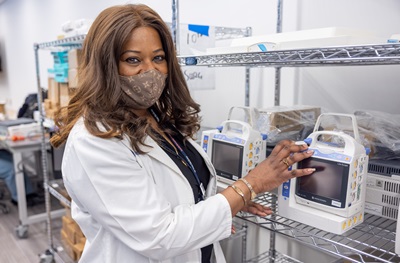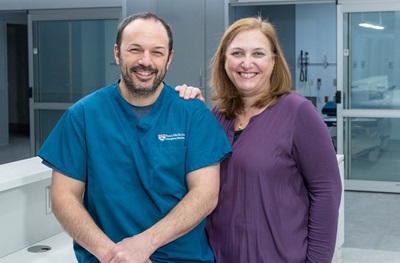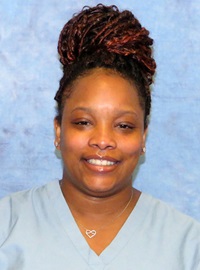From the earliest days of creating the Pavilion's initial architectural design, HUP’s Pavilion has always been a “team of teams” effort, pulling in feedback and ideas from staff and faculty from an array of disciplines. Now, with the facility's opening coming in the fall, it's all hands on deck to bring the mix of expertise needed to put patient care in motion there.
We're sharing stories of some of these expert contributors leading up to the Pavilion opening. Below, get to know a few of them, and follow along as we introduce more on Facebook in the coming months.
Martine Kersaint
 In today’s high-tech, health care environment, ensuring that all medical devices used in hospitals operate at their peak performance is crucial to patient care. Martine Kersaint, MBA, HUP’s senior clinical engineering manager, knows this well. In a field traditionally dominated by men, she is in charge of a team of 20 employees who are responsible for diagnosing medical equipment problems, repairs, preventative maintenance, and quality assurance for the nearly 30,000 medical devices at HUP.
In today’s high-tech, health care environment, ensuring that all medical devices used in hospitals operate at their peak performance is crucial to patient care. Martine Kersaint, MBA, HUP’s senior clinical engineering manager, knows this well. In a field traditionally dominated by men, she is in charge of a team of 20 employees who are responsible for diagnosing medical equipment problems, repairs, preventative maintenance, and quality assurance for the nearly 30,000 medical devices at HUP.
Now, with the opening of the Pavilion, rows of ventilators, EKG machines, and patient monitors stretch throughout the rooms on the Mezzanine floor of the new hospital building, waiting to be checked in, examined, and tested thoroughly. Indeed, she and her team will repeat this process for every one of the 32,000 medical devices to be used in the new facility, making sure they’re all in perfect working order.
“It’s all about safety,” she said. “It could be one of our own relative’s lives depending on one of those machines.”
Read more here
Benjamin Abella and Ursina Teitelbaum
 It’s all in the “family”. That’s how Benjamin Abella, MD, MPhil, professor and vice chair for Research in Emergency Medicine and director of the Center for Resuscitation Science, sees his work with Ursina Teitelbaum, MD, associate professor and clinical director of the Penn Pancreatic Cancer Research Center. “I help her think through problems when her patients have an urgent condition, and she helps guide me when I take care of her cancer patients in the ED.” It’s a professional connection that starts at home: They’ve been married for almost 20 years.
It’s all in the “family”. That’s how Benjamin Abella, MD, MPhil, professor and vice chair for Research in Emergency Medicine and director of the Center for Resuscitation Science, sees his work with Ursina Teitelbaum, MD, associate professor and clinical director of the Penn Pancreatic Cancer Research Center. “I help her think through problems when her patients have an urgent condition, and she helps guide me when I take care of her cancer patients in the ED.” It’s a professional connection that starts at home: They’ve been married for almost 20 years.
While tapping each other’s knowledge for patient care is not uncommon for a “HUP-ple,” the opening of the Pavilion will make this clinical connection even easier. “Having the ED and my oncology floors housed in one building, the Pavilion, will make it even easier to integrate my care. It will be easy for me to visit my patients in the ED, easy for Ben to work with oncology teams and nurse navigators, and easier to coordinate cancer patients’ workups and care efficiently,” Teitelbaum said.
Abella is equally excited about the Emergency Department’s new space. “It’s designed to meet our needs in the ED and beyond, from individual ED exam rooms to state-of-the-art technologies for caregivers and patients.”
Read more here
Angelica McCoy
 As one of the sterile processing technicians in Penn Medicine’s recently opened Interventional Support Center, Angelica McCoy makes sure each instrument set she puts together is clean, sterilized, and complete. Her role is a vital part of patient care… and requires specific skills and knowledge. In fact, becoming a sterile processing technician requires significant training, including successful completion of a certification program through a combination of work experience and an examination.
As one of the sterile processing technicians in Penn Medicine’s recently opened Interventional Support Center, Angelica McCoy makes sure each instrument set she puts together is clean, sterilized, and complete. Her role is a vital part of patient care… and requires specific skills and knowledge. In fact, becoming a sterile processing technician requires significant training, including successful completion of a certification program through a combination of work experience and an examination.
Right now, assembled instrument sets at the ISC are loaded onto case carts and shipped to HUP, Pennsylvania Hospital, or one of the outpatient facilities the currently ISC supports — the Perelman Center and the Ambulatory Surgery Center at Rittenhouse. But, when the Pavilion opens in the fall, McCoy will be assembling instrument sets for its ORs as well. And the ISC is ready for the increase. It is designed to process instruments from up to 200 cases each day.
The ISC has brought together technicians into one space, as a team. Previously they worked in smaller teams at each location. McCoy likes the new setup. “It’s nice to have everyone in the same space, ” she said. And she loves the feeling of accomplishment with every set she puts together. “Before I finish assembling, I say a prayer for the recipient of the set, ” said McCoy. “There is a face to every set I assemble.”
Read more here